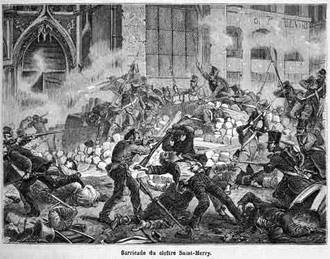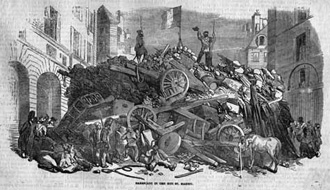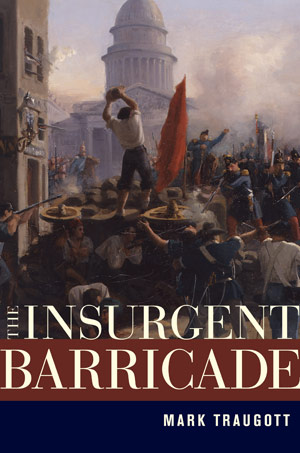
Although it was only in the course of the nineteenth century that the barricade emerged as the preeminent symbol of the modern revolutionary tradition, its origins can be traced as far back as sixteenth-century France.
The great cyclical peaks in the history of French contention—the “Day of the Barricades” in Paris in 1588, the second “Day of the Barricades” in 1648, and the revolutions of 1789, 1830, and 1848—mark major turning points in the evolution of this technique of insurrection. They succeeded in transforming a custom that had remained exclusively French for the first two hundred years of its existence into a pan-European phenomenon.
The remarkable persistence and eventual diffusion of barricades must be understood in terms of the crucial functions they perform in insurrectionary situations. The most obvious are practical in nature and help explain the tactic’s initial adoption: providing cover for insurgents on the one hand, and serving to isolate troops and prevent their free circulation on the other.
Less evident, but no less essential, are a series of sociological functions that include mobilizing the population and attracting new recruits to the insurgent cause, building solidarity among participants and helping them to gauge their chances of success, identifying leaders and facilitating the emergence of an efficient division of labor among the barricade’s defenders, and making it possible for insurgents to fraternize with soldiers and police in an effort to sway their loyalties.
In the modern era, after the military began to make systematic use of artillery and experimented with new strategies for the repression of civil unrest, the purely pragmatic utility of the barricade diminished. But the barricade’s symbolic functions became more prominent, highlighting the central role of barricades in a culture of insurrection that gradually assumed global proportions.

“Through the study of the barricade, we learn about the almost ritualized nature of the preliminaries to violent civil conflict and the complex byplay that accompanies the actual fighting, as insurgents launch fraternal appeals aimed at winning over troops whose officers battle valiantly to retain the loyalty of the rank and file.”
My interest in barricades was sparked by earlier research on the Parisian insurrections of February and June 1848. Like so many other aspects of French revolutionary history, the construction of barricades seemed to have acquired an almost obligatory character. It had become a sort of tropic reaction to which insurgents turned whenever the threat of civic unrest loomed.
I was struck by the tendency for barricades to reappear, often in the identical location and configuration, in one insurrection after another. I was fascinated by the problem of how such a high degree of consistency was achieved, even though most participants in insurrectionary events were previously unknown to one another, and even though no previous barricade event might have occurred within living memory. These mysteries caused me to reflect upon the nature of popular protest and to revisit what is known of how it is organized and sustained over time.
When people contest existing social arrangements, they typically revert to a limited number of well established and widely recognized techniques of protest—even if some novel approach might seem to offer a more promising path to the achievement of their objectives.
In the present day, the demonstration, the strike, or the “media event” are among the common forms of contention that we take for granted, even though they are all inventions of the past two hundred years or so. Before that time, other conventions, now outmoded—the food riot, tax revolts, or shaming ceremonies like the charivari, for example—dominated the activities of insurgents. The array of all such standard routines available at a given time and place constitutes what the historian and sociologist Charles Tilly called a people’s “repertoire of collective action.”
These recurrent patterns of protest exhibit remarkable continuity over long swaths of historical time. Only at extremely long intervals does a society’s repertoire undergo the sort of sweeping, wholesale change that occurred in Europe at the start of the modern era, roughly between the eighteenth and nineteenth centuries. This resulted in the eclipse of the old-style repertoire, which had few points of similarity or overlap with the one that replaced it.
Remarkably, the barricade has constituted the great exception to that pattern: not only did the barricade figure prominently in the great events of the early modern period, it somehow managed to survive and prosper into the twentieth century, and now in the twenty-first.
Understanding what made this unique outcome possible sheds light on the long-term evolution of a society’s methods for effecting change even as it demonstrates how innovations in techniques of protest tend to coincide with discrete peaks in the cycle of collective action.

The search for the origins of the barricade and attempts to identify the key moments in its evolution led me to some surprising conclusions.
For example, it has long been accepted that the barricade originated at the time of the First Day of the Barricades in 1588. Indeed, the standard account even assigns its “invention” to a specific date (May 12), a precise location (the Place Maubert in Paris), and a particular individual (Charles de Cossé, compte de Brissac, who is said to have instructed the supporters of the Duke of Guise in how to build the first such structure).
The historical record, however, provides a far more muted and ambiguous picture. I found no fewer than three distinct versions of how barricades came to be constructed in 1588, and they differ in most particulars, including both when the plan was devised and who was responsible for this innovation.
As I looked into the matter more closely, I came to believe that about the only thing these various accounts of the origins of the barricade had in common was the fact that they are all wrong.
My conclusion was initially based less on historical documentation than on linguistic evidence. In effect, the first use of the French word “barricade” dates from 1570 when it was used to describe a battle in Mont-de-Marsan, a town in the southwest of France caught up in the wars of religion that were then raging in that region. If the term itself existed at this earlier date, then the concept of the barricade—and, of course, the thing itself—must also have existed.
It was this line of inquiry that convinced me that I needed an explicit and carefully constructed definition of the insurgent barricade as something more than a physical object, requiring both a certain shared understanding of the concept and a clearly articulated relationship to the insurrectional setting.
The case of the barricade also led me to examine the problem of retracing historical origins in general. Historians’ tendency to invest the moment of origination with a spurious precision—here exemplified by the standard account of the invention of the barricade by a well documented individual who played a central role in one of the landmark events of the era, one which just happened to take place in the most important and storied city of the realm—flies in the face of the reality uncovered by patient inquiry. The consistent lesson is that origins lie shrouded in uncertainty because they are the result of a gradual process involving multiple overlapping steps, more or less simultaneously undertaken by a number of independent actors, most of whom stubbornly resist efforts to penetrate their anonymity.
My investigation into the origins of the barricade thus not only complicated the story as it has customarily been told but offered the opportunity to reflect on the reasons why origin myths are so common and persistent.
In my efforts to pinpoint the critical moments in the development of a barricade culture, I was also surprised to learn that the period of the French Revolution was one in which this insurrectionary technique was in frequent use. This can only be considered surprising in light of the fact that there has been virtually no acknowledgment of the role barricades played in those events, and in fact the categorical assertion on the part of a number of prominent historians that none existed at all.
In reality, the barricade played a minor but consistent role in many of the key events of that period—including not only July 14, 1789 but also the Flight to Varennes and the Parisian insurrections of Prairial and Vendémiaire in 1795.
This opportunity to broaden historians’ awareness of the incidence of barricade events seemed all the more important because this was the very period that witnessed Belgians’ use of barricades in the Brabant revolution, the first appearance of the tactic outside its country of origin.
“The consistent lesson is that origins lie shrouded in uncertainty because they are the result of a gradual process involving multiple overlapping steps, more or less simultaneously undertaken by a number of independent actors, most of whom stubbornly resist efforts to penetrate their anonymity.”
My work lies at the intersection of the disciplines of history and sociology. I am interested in the ways that long-term patterns in the form of violent conflict reflect the changing relationship between those in power and those who seek to influence or overthrow them.
The construction of barricades, though a relatively rare occurrence in any given time or place, has persisted for more than four hundred years and remains a highly visible form of modern contention. The history of this technique of insurrection is significant for what it reveals about the motives and intentions of forces on both sides of a civil conflict and for what it teaches us about how the methods of protest available to the members of society originate and evolve.
Through the study of the barricade, we learn about the almost ritualized nature of the preliminaries to violent civil conflict and the complex byplay that accompanies the actual fighting, as insurgents launch fraternal appeals aimed at winning over troops whose officers battle valiantly to retain the loyalty of the rank and file.
The acts of heroism, self-sacrifice, vainglory, and desperation that the barricade inspires explain why it has become the iconic representation of a tradition of revolution that now spans the globe.


Mark Traugott is Professor of History and Sociology at the University of California at Santa Cruz. Besides The Insurgent Barricade, featured in his Rorotoko interiview, he is the author of Armies of the Poor: Determinants of Working-Class Participation in the Parisian Insurrection of June 1848 (1985), The French Worker: Autobiographies from the Early Industrial Era (1993), and Repertoires and Cycles of Collective Action (1995).